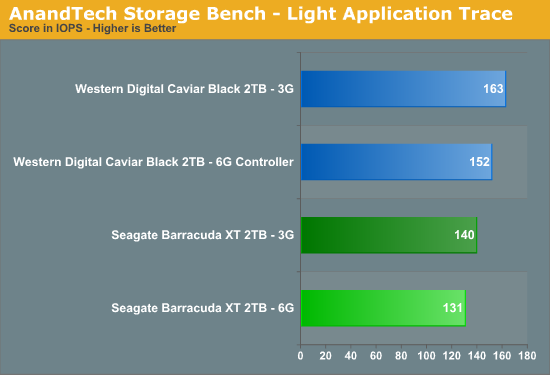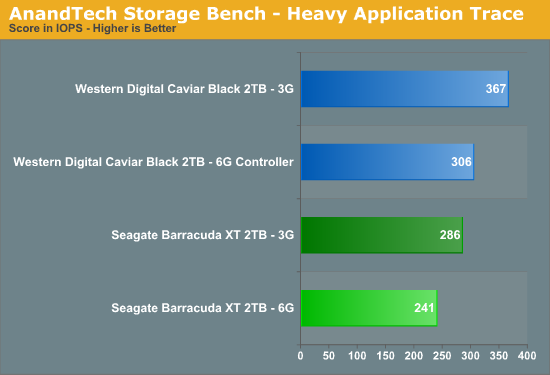Seagate Barracuda XT 2TB: SATA 6Gb/s Performance Preview
by Gary Key on October 29, 2009 12:00 AM EST- Posted in
- Storage
AnandTech Storage Bench Results –
Finding good, real world, storage benchmarks is next to impossible. The synthetic tests work up to a certain point but you need real world examples. Measuring performance in individual applications often ends up with charts like these where all of the drives perform identically. Benchmark suites like PCMark Vantage are the best we can do, but they are a bit too easy on these drives in my opinion and while representative of a real world environment, they aren’t necessarily representative of all real world environments.
Recently we’ve been able to get our hands on a piece of software that allows us to record all disk activity on a machine and then play it back on any other machine. The point is that we can now model a real world usage scenario without waiting for BAPCo or Futuremark to do it for us. The performance results are reported in I/O Operations per Second (IOPS).
The first in our new benchmark suite is a light usage application case. The Windows 7 system is loaded with Firefox, Office 2007 and Adobe Reader among other applications. With Firefox we browse web pages like Facebook, AnandTech, Digg and other sites. Outlook is also running and we use it to check emails, create and send a message with a PDF attachment. Adobe Reader is used to view some PDFs. Excel 2007 is used to create a spreadsheet, graphs and save the document. The same goes for Word 2007. We open and step through a presentation in PowerPoint 2007 received as an email attachment before saving it to the desktop. Finally we watch a bit of a Firefly episode in Windows Media Player 11.
There’s some level of multitasking going on here but it’s not unreasonable by any means. Generally the application tasks proceed linearly, with the exception of things like web browsing which may happen in between one of the other tasks.
The recording is played back on all of our drives here today. Remember that we’re isolating disk performance; all we’re doing is playing back every single disk access that happened in that ~5 minute period of usage. The light trace is composed of 37,501 reads and 20,268 writes. Over 30% of the IOs are 4KB, 11% are 16KB, 22% are 32KB and approximately 13% are 64KB in size. Less than 30% of the operations are absolutely sequential in nature. Average queue depth is 6.09 IOs.

The Marvell controller is 7% slower than the Intel controller with the WD drive and once again 7% with the Seagate drive. The WD drive is up to 24% faster than the Seagate drive depending on the controller configuration.
If there’s a light usage case there’s bound to be a heavy one. In this test we have Microsoft Security Essentials running in the background with real time virus scanning enabled. We also perform a quick scan in the middle of the test. Firefox, Outlook, Excel, Word and Powerpoint are all used the same as they were in the light test. We add Photoshop CS4 to the mix, opening a bunch of 12MP images, editing them, then saving them as highly compressed JPGs for web publishing. Windows 7’s picture viewer is used to view a bunch of pictures on the hard drive.
We then use 7-zip to create and extract .7z archives. Downloading is also prominently featured in our heavy test; we download large files from the Internet during portions of the benchmark, as well as use uTorrent to grab a couple of torrents. Some of the applications in use are installed during the benchmark, Windows updates are also installed. Towards the end of the test we launch World of Warcraft, play for a few minutes, then delete the folder. This test also takes into account all of the disk accesses that happen while the OS is booting.
The benchmark is 22 minutes long and it consists of 128,895 read operations and 72,411 write operations. Roughly 44% of all IOs were sequential. Approximately 30% of all accesses were 4KB in size, 12% were 16KB in size, 14% were 32KB and 20% were 64KB. Average queue depth was 3.59.

The Marvell controller is 19% slower than the Intel controller with the WD drive and 18% with the Seagate drive. The WD drive is up to 28% faster than the Seagate drive.
Our final test focuses on actual gameplay in four 3D games: World of Warcraft, Batman: Arkham Asylum, FarCry 2 and Risen, in that order. The games are launched and played, altogether for a total of just under 30 minutes. The benchmark measures game load time, level load time, disk accesses from saved games and normal data streaming during game play.
The gaming trace is made up of 75,206 read operations and only 4,592 write operations. Only 20% of the accesses are 4KB in size, nearly 40% are 64KB and 20% are 32KB. A whopping 69% of the IOs are sequential, meaning this is predominantly a sequential read benchmark. The average queue depth is 7.76 IOs.

Not much else to say here, the Marvell controller is 6% slower than the Intel controller with the WD drive and 9% with the Seagate drive. The WD drive is up to 8% faster than the Seagate drive.










55 Comments
View All Comments
rachotilko - Tuesday, November 10, 2009 - link
I don't get it ! Who needs single drive over 1TB ? We all need a wide availability of affordable hardware RAID controllers. RAID6 array of say 8x500GB drives offers speed, reliability & capacity that no single drive can ever dream of. But please no more FakeRAID junk, please.abuda - Monday, November 2, 2009 - link
how about this stuff ?http://www.mwave.com/mwave/SKUSearch_v3.asp?px=IM&...">http://www.mwave.com/mwave/SKUSearch_v3.asp?px=IM&...
without shipping
mindless1 - Sunday, November 1, 2009 - link
utilizing the word utilize can become excessivesonofliberty - Sunday, November 1, 2009 - link
should run a RAID 0 benchmark on all drive to see the benefits of SATA 6GB/smichael19 - Saturday, October 31, 2009 - link
are the forums ever coming back?Nocturnal - Saturday, October 31, 2009 - link
Anand said via Twitter that he'd have a better ETA this weekend. So hopefully we'll get some type of update.ClagMaster - Friday, October 30, 2009 - link
Given what I know about harddrives, the above results are not terribly surprising. What limits the data bandwidth of a harddrive is the bottleneck between the harddrive controllers and the platters, which is much less than 3Gb/s. This is not going to change anytime soon for mechanical harddrives.However, for SSDs, there is no such bottleneck. SSD's with SATA 6Gb/s is something more easily realized in the near future. Still, we are going to need to wait about 2 years for the appropriate SSD controllers, dedicated motherboard PCIe lanes, and cheaper faster flash memory, to be developed to allow this to happen.
Not a bad article, but SATA 6Gb/s on harddrives?
Rouche - Friday, October 30, 2009 - link
My last disk (7200.11 firmware error) got into a BSY state after 6 month of use, lost everything, no support to recover my data.Even if i had a gun on the head, i would never touch a Seagate disk.
Nocturnal - Saturday, October 31, 2009 - link
Seagate has offered free data recovery on the disks that experienced this problem. There is also an easy fix although you have to either buy or make your own custom cable in order to unbrick the drive.Rouche - Monday, November 2, 2009 - link
Seagate has offered? Im sure they yelled this on every houses roof!Of course i tryed the custum unbrick with serial communication but it seems to worse. My luck i guess.